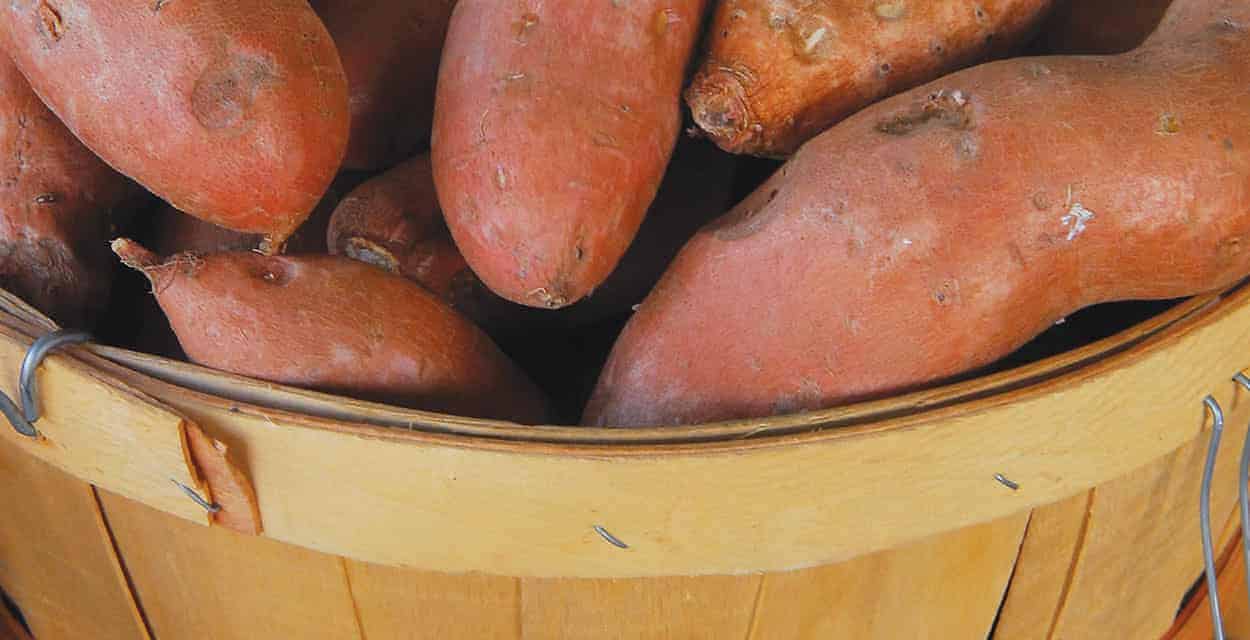A Guide to Sweet Potatoes in the High-Desert Garden and Kitchen
By Willy Carleton

Several years ago, when I told a few neighbors that I planned to grow sweet potatoes on a low-lying acre along the Rio Chama, I received friendly warnings that my efforts would likely yield only small, scraggly roots in the northern, high-altitude climate. I had already purchased the seed stock, however, and stubbornly pushed forward with the plan. Besides, I loved experimenting with new crops, so I grasped at the old truism, “There are no gardening mistakes, only experiments.”
Sweet potatoes, I learned, have long been grown in the southern part of the state. In 1896, ranchwoman Edith Nicholl declared sweet potatoes to be a “champion vegetable crop” for southern New Mexico, and, nearly fifteen years later, state horticulturalist Dr. Fabián García wrote extensively on its production in the state’s lower valleys. From the Mesilla Valley to Portales, farms throughout the past century have produced large numbers of the root vegetable. Though the iconic chile pepper often basks in the culinary spotlight in New Mexico, many lesser-known crops like the humble sweet potato thrive here.
Still, northern New Mexico’s short growing season seemed problematic and threatened to justify my neighbors’ skepticism. Throughout a long hot summer, which included an August visit from a swarm of grasshoppers that ate the plants to the ground, I weeded diligently while wondering if it was all just a fool’s errand. When I dug the first sweet potato sometime in late September, however, a healthy, two-pound cluster of plump, orange roots hung from the base of the plant. Every year since, though all the other crops I have grown seem to come and go, sweet potatoes remain a staple in my field. Sweet potatoes, I determined, can reclaim their status as champions of the garden even in the state’s northern stretches.
Sweet potatoes make good sense in many garden schemes for a variety of reasons. They do not require extremely fertile soil and actually thrive in sandier soils, where other crops might suffer; they can provide a useful ground cover in a polyculture design; and, when cooked, sweet potato greens are a tasty addition to summer sauces and stir-fries. High in fiber, beta carotene, vitamins and minerals, and (in the peel) antioxidants, sweet potatoes provide an array of potential health benefits. And, of course, there’s the opportunity to grow tasty varieties absent from most local supermarkets or farmers markets.
Sweet potatoes do not require a particularly green thumb. To plant a sweet potato, do not plant the actual root, or pieces of the root, as you would a regular potato. Instead, sprout the sweet potato and plant the sprouts, which are called “slips,” once they are about five to eight inches long. Although there are many mail-order options for purchasing slips, the single best tip I can offer is to grow your own slips. While at first, this added step might seem intimidating, it is in fact very easy and provides a host of benefits. Homegrown slips will have a survival rate approaching one hundred percent once planted, whereas mail-order slips, in my experience, survive, at best, at a rate around eighty percent. Second, starting your own slips allows you to plant exactly when is best for you and the slips, like when the nighttime temperatures for the week ahead look warm. Third, starting your own slips lets you know for sure that your seed stock is free of a menacing, and common, soil-borne fungal disease called scurf (this cosmetic disease makes sweet potatoes take on dark splotches and is easy to detect, and therefore avoid, when choosing seed). Fourth, you will be able to choose more interesting varieties to grow. The most common varieties of slips available in many seed catalogs, such as Beauregard, Covington, or Jewel, typically produce high yields and have growth habits that allow for easy harvesting with a tractor. In the home garden, however, rarer varieties, such as purple-fleshed sweet potatoes or heirlooms like the “Ginseng” variety, might take a little more time to dig but will reward your efforts with tastier meals. Finally, you will save money; just a few sprouted sweet potatoes will provide enough slips for an entire garden.

One of the easiest ways to start your slips is by placing a sweet potato in a one-quart canning jar, half-filled with water. In Albuquerque and farther north, the best time to start slips is in late March or early April. After about six weeks, the top half of the sweet potato will have sprouted green vines. Once these vines are four inches or longer, you can break them off at the stem and plant them. There is little advantage in planting sweet potatoes too early (their growth will only stunt), so plan on putting them in the ground around the first of June, or whenever chances of nighttime temperatures in the thirties has passed. Once you pick your first round of slips, wait another week or two and pick the second “crop” of slips from the same sweet potato. Although sweet potatoes will continue to produce slips all year, plant sweet potatoes you plan to harvest for their roots by the third week in June; anything planted later will probably not have enough time to mature.
Plant your slips about a half inch deep in soil and about a foot and a half apart. If part of your garden is especially sandy, this would be a good place for your sweet potatoes. Make sure the soil around the plants stays consistently moist for the first week or two; once established, sweet potatoes withstand drought relatively well. Keep them weeded through July; by August, they should start to vine out and provide some of their own weed protection with their heavy foliage.
A sweet potato, unlike a potato, is not a tuber; it is the actual enlarged lateral root of the plant. As such, the sweet potatoes will only get larger the longer they grow. Once the nights start getting cold, usually in early October (but these days, who knows—Thanksgiving?), consider harvesting your roots. If you get a light freeze and the greens turn black, do not worry. Simply mow off the tops at the base of the plant. Although they will last undamaged in the ground as long as the soil temperature remains above 55 degrees Fahrenheit, I try to dig my sweet potatoes within a week after the first freeze. Dig with a shovel or a digging fork, and be sure to be gentle with the roots, which bruise easily during and immediately after the harvest.
The final step to ensure a good outcome is to cure your sweet potatoes. This process will help scarify any cuts to the skin, will increase the storability of your crop, and will greatly improve their taste. One easy method to cure a small amount of sweet potatoes from the garden is to simply put them, unwashed, into a box with ventilation (a used five-gallon plastic flower pot, an old waxed produce box, or a cardboard box punched with small holes would all work), and cover the box with a moist towel. The moisture in the remnant soil on the roots, along with the wet towel, should increase humidity in the box and help the roots cure. Check the moisture of the towel every day or two and re-moisten, if necessary. Place the box in a warm, dark place, such as atop a refrigerator or near a heating vent, and let them sit for about a week. After that, you just have to decide how to eat them.
Try some of our favorite sweet potato recipes!
Willy Carleton is the former co-editor of edible New Mexico and The Bite. He is the author of Fruit, Fiber, and Fire: A History of Modern Agriculture in New Mexico, which explores the cultural and environmental history of apples, cotton, and chiles in our region.













